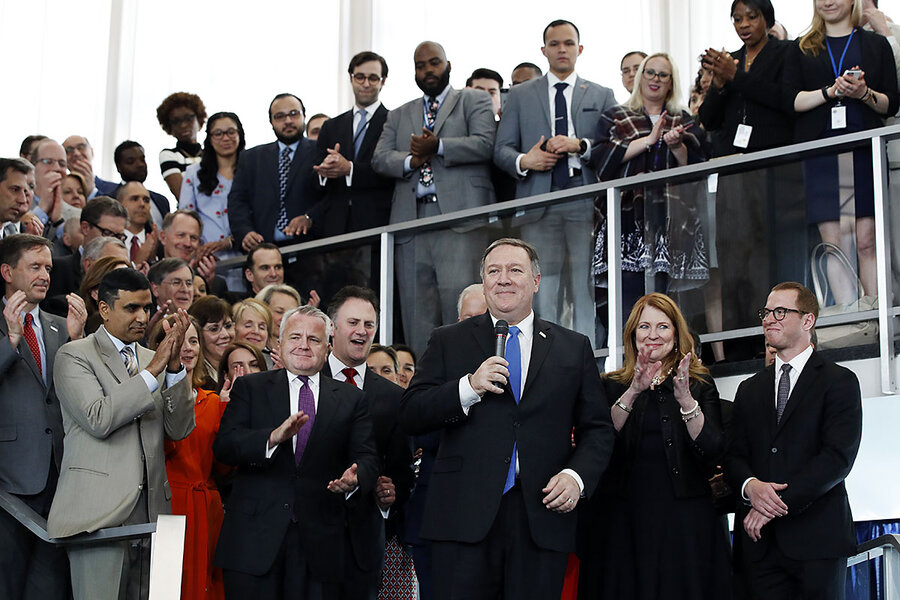Pompeo's dilemma: World and State both need immediate attention
Loading...

| Washington
When Mike Pompeo was finally able to address State Department employees as the new secretary of State last week, it was only after he had dashed off to Europe and the Middle East within hours of his April 26 Senate confirmation.
Mr. Pompeo’s delayed arrival to take the reins of the State Department underscores the mix of priorities the Trump administration’s top diplomat faces in the coming weeks. It’s a delicate balance he’ll have to strike between in-house refurbishment and time-consuming global diplomatic engagements that demand his attention.
On the one hand, Pompeo says his top priority will be to get down to repairing the nation’s deeply damaged diplomatic infrastructure – what he likes to call giving US diplomats their “swagger” back.
Why We Wrote This
When Mike Pompeo was nominated as secretary of State he was touted as just the administrator the understaffed State Department needed to right the ship and improve morale. But from Day 1 the foreign-policy challenges have been historic and unrelenting. Can he handle both areas of responsibility at once? He may have to.
But on the other, he launches into this task at a particularly high-stakes moment in US diplomacy, when the secretary of State will be in high demand both at the White House and for consultations with US allies and partners.
Consider just a short list: Iran, Jerusalem, China, and of course North Korea.
Tuesday afternoon President Trump announced he was withdrawing from the Iran nuclear deal and reimposing sanctions on oil sales, a decision that up-ends US policy on a top international issue. In so doing, he’s created a situation that will certainly require intensive diplomatic engagement from the new secretary of State.
On Monday the US dedicates its new embassy to Israel in Jerusalem. And even though Pompeo decided against leading the US delegation at the ceremony marking the embassy’s move from Tel Aviv, he’ll still need to be up to speed on the move and ready to deal with its repercussions.
Relations with China and the looming issue of Mr. Trump’s tariffs and the threat of a trade war with the world’s second-largest economy can’t be put off for long.
'Historic opportunity'
And then there’s the small matter of Trump’s summit with North Korean leader Kim Jong-un sometime within the next month – and all the intricate and complex preparations that entails. In fact, Trump said during his statement on Iran Tuesday, Pompeo would soon arrive in North Korea for pre-summit groundwork.
Pompeo’s uniqueness as the one US official who has met with Mr. Kim (when Pompeo was still CIA director) means he will be indispensable to Trump’s bid to deliver a successful summit.
“For the first time in the Trump administration there is a genuine and historic foreign-policy opportunity,” says Aaron David Miller, a Middle East negotiator with extensive State Department experience who is now vice president for new initiatives at the Woodrow Wilson Center for Scholars in Washington. “So really all the other stuff, and certainly reform at the State Department, becomes almost irrelevant.”
At the same time, however, Pompeo’s prep for the Trump-Kim summit will be all the more difficult because of the depleted ranks of senior-level US diplomats in the wake of departed Secretary of State Rex Tillerson’s chaotic and debilitating efforts to downsize the State Department.
Yet the summit’s imminence means Pompeo won’t have much time to fill the gaps in US-Asian diplomacy.
The magnitude of the internal and external demands Pompeo faces may be particularly acute for an entering secretary of State, but the tangle of in-house and global priorities is not in and of itself so unusual, diplomatic experts say.
What does set Pompeo’s predicament apart, some add, is that he takes on his dual-track job within an administration – and specifically for a president – that does not seem to assign much value to the role the nation’s diplomats play.
Vacancies at State
“A capable secretary of State, which by all accounts Secretary Pompeo is a capable person … should be able to chew gum and walk at the same time, including on two major diplomatic initiatives,” says a former State Department senior official, who requested anonymity to speak freely about a new administration.
But “one secretary can’t be everywhere at the same time [so] the only way that you can actually manage active crises in multiple places is to empower the institution in which you’re working,” the former senior official adds. And despite some early indications from Pompeo of his intentions to put the State Department back at the center of US diplomacy, the former official says the administration’s track record suggests a difficult road ahead.
“No senior foreign service officers or diplomatic officials have been brought in to the president’s inner circle or the National Security Council.… Diplomats at the State Department have not felt empowered, [and] career experts have not felt empowered to work on the files that are in their areas of responsibility,” he says.
“So unless there is a massive sea change in terms of this administration’s prioritization of diplomacy and empowerment of people who are actually career experts,” he adds, “it’s going to be very difficult to manage all this at once.”
Mr. Tillerson left the State Department with 8 of the 10 most senior department positions vacant, and his was the only department under the Trump administration to implement a hiring freeze. The US also still has dozens of vacant ambassadorships, including the critical post in Seoul, South Korea.
With so many key positions to fill, and with some obstacles to filling them that are peculiar to this administration – for instance, Trump has until now rejected offering jobs to any of the many prominent Republican foreign-policy experts who signed “Never Trump” letters during the presidential campaign – some experts estimate it could take Pompeo a year of focused attention to round out his diplomatic team.
On top of all this is the reality that Pompeo may want to tap his own choices for the positions that are key to the front-burner foreign-policy crises of the moment. So for example, Pompeo is not expected to go with Tillerson’s choice of having acting assistant secretary for East Asia Susan Thornton take on the post permanently – even though the always-important position is particularly front and center now, given the upcoming summit and North Korea nuclear standoff.
Mr. Miller of the Wilson Center, who has advised six secretaries of State, says Pompeo is entering uncharted territory with the tandem of a hollowed-out diplomatic corps and numerous hot-button international issues to master. “There’s no precedence for this, there are no parallels” he says, “so let’s just start de novo.”
Constituency in Congress
But Miller says Pompeo has several advantages going for him as he hews this unusual path.
“First, he knows how to talk to Trump,” he says – and that means “he has a reasonable chance of becoming the adviser with the most significant impact and the repository of foreign policy under this president.”
Another substantial advantage Miller sees in Pompeo’s column is the congressional support he can count on as he goes about revitalizing the State Department. “He’s got a constituency in Congress very much against this hollowing out of the department,” he says.
Miller says he took Pompeo’s decision to head off to a NATO foreign ministers meeting in Brussels within hours of his Senate confirmation as a strong signal of his priority of becoming the president’s foreign-policy communicator and voice to the world. “By making this trip to NATO and the Middle East before anything else, he was highlighting his effort to establish himself at the center of Trump foreign policy,” he says.
But that’s where Pompeo’s other task of rebuilding and revitalizing the diplomatic corps comes in, Miller says. “To get that first objective done he needs people to help him,” he adds, “and that means he’s going to need people at the State Department.”






